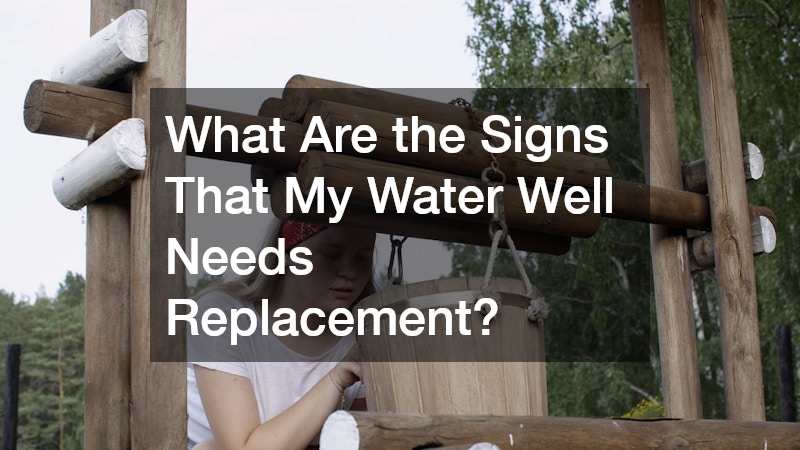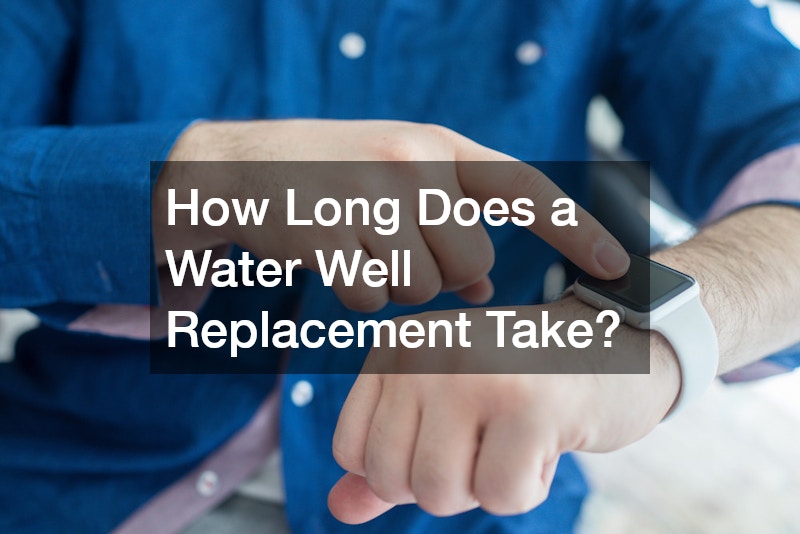Water Well Replacement Services You Can Count On
When your water well begins to show signs of decline, it can impact everything from your daily routine to your long-term property value. Clean, reliable water is essential, especially in rural areas where municipal water systems aren’t available. That’s why dependable water well replacement services are so critical. Whether your current well is suffering from contamination, low yield, or mechanical failure, a well-designed replacement can restore functionality and peace of mind.
In this comprehensive guide, we’ll explore everything you need to know about water well replacement—from warning signs to watch for, to the actual steps involved, and how to choose the right professionals for the job. We’ll also debunk common myths and provide insight into long-term maintenance to help protect your investment. Whether you’re working with water well companies for the first time or you’re familiar with well drillers and pump systems, understanding the scope and value of replacement services will put you in a strong position to act confidently. Let’s dive in.
1. What Are the Signs That My Water Well Needs Replacement?

1.1. Decreased Water Quality
A noticeable change in water taste, odor, or clarity can signal a failing well. Contaminants from nearby septic systems, agricultural runoff, or aging components may be infiltrating the system. When filtration and treatment no longer suffice, replacement services may be necessary to ensure safe water. You might also notice increased sediment or discoloration, both of which suggest the well casing or screen has degraded. While water extraction can temporarily improve flow, ongoing issues usually point to deeper structural failure. At this point, many homeowners turn to water well companies to evaluate the system. If water testing continues to show contamination or unusual mineral levels despite intervention, it’s often time for a full replacement.
1.2. Frequent Pump Failures
If your system requires constant water well pump repair, it could be a sign of larger structural issues. Replacing individual components may provide temporary relief, but recurring issues often point to a well that has reached the end of its lifespan. Frequent pump cycling, pressure tank problems, or burnt-out motors are red flags. When basic well pump services no longer resolve the problem, a failing well may be compromising the entire system. This is especially true for older water wells, where sediment buildup and outdated construction methods limit repair success. Consulting with well drillers can help determine if continued repairs are cost-effective—or if full replacement services are the smarter option.
1.3. Unusual Noises or Vibrations
Strange noises from the well pump or vibrations in your plumbing system can indicate deeper problems. Worn-out components or improper installation could be to blame, requiring full replacement services for a long-term fix. Grinding, rattling, or humming sounds could signal that the pump is struggling against resistance—possibly due to clogged lines or collapsed well walls. Water well companies often investigate these issues with video inspection tools. If they discover misalignment, obstructions, or shifting well casing, it may be more economical to replace the well entirely. Properly functioning water wells should operate quietly, so odd noises are worth a closer look, especially when paired with other symptoms.
2. How Much Does Water Well Replacement Cost?
2.1. Factors Affecting Replacement Costs
Several elements influence cost, including well depth, soil type, accessibility, and whether water extraction services are needed during the transition. Labor rates and equipment used by well drilling contractors also play a role. The condition of your existing system can affect pricing too. For example, if the old well must be decommissioned with environmental oversight, expect additional fees. Water well installation in rocky or hard-to-drill areas typically costs more due to increased equipment wear and labor time. Local permitting and inspection fees also vary by location, impacting the final bill. If your replacement involves a high-capacity setup or water treatment integration, that further drives up costs.
2.2. Breakdown of Common Expenses
Expect costs related to site assessment, permitting, drilling, pump systems, and final water testing. Well pump services, including installation and calibration, are often billed separately. A basic residential well replacement can range from $5,000 to over $15,000 depending on specifications. You’ll likely see line items for trenching, electrical hookup, pressure tanks, and backfilling. If water well pump repair is needed temporarily before full replacement, that adds to total expenses. Additionally, post-installation water testing is required to verify safety and compliance with health codes. Working with reputable water well companies helps ensure cost transparency, as they often provide detailed project estimates and a clear breakdown of all charges.
2.3. Comparison of DIY vs. Professional Replacement
While DIY options might seem cheaper, the risks are high. Professional water well companies bring essential expertise, compliance with regulations, and specialized equipment—making professional replacement services a safer, more cost-effective choice. Drilling a new well requires permits, knowledge of aquifer depths, and accurate siting. A DIY attempt without this knowledge can cause irreversible contamination or create an unstable system. Licensed well drilling contractors not only meet legal requirements but also ensure the system functions efficiently long-term. Their equipment allows for precise drilling, casing, and pump installation. Unless you’re a certified well driller with access to industrial tools and permits, this isn’t a job to take on yourself.
3. What Is the Process for Replacing a Water Well?
3.1. Initial Assessment and Inspection
Well drillers begin with a detailed inspection to determine structural integrity, yield, and water quality. If replacement is advised, the team maps out a plan for safe decommissioning of the old well and installation of the new one. They’ll often review historical data from previous water well pump repair visits and assess flow performance through a series of tests. Soil sampling and groundwater evaluation are part of the planning process. The depth, slope, and geological conditions all influence how the replacement proceeds. A reputable water well company will also advise you on nearby water wells and help ensure your new system won’t negatively impact neighboring water tables.
3.2. Removal of the Old Well
Old wells must be properly sealed and documented to prevent contamination. This step often involves coordination with environmental agencies and licensed well drilling contractors. The process may include backfilling with bentonite clay or cement grout to protect surrounding aquifers. Water extraction from the old well is typically ceased entirely, and the casing is often cut below grade to eliminate hazards. Improperly abandoned wells pose serious risks, including groundwater pollution and injury. Replacement services that follow regulatory best practices ensure your property stays safe and legally compliant. You may be required to submit closure documentation before the new water well installation can proceed.
3.3. Installation of the New Well
Modern water well installation follows strict engineering guidelines. It includes casing, gravel packing, and pump installation. A thorough water extraction test ensures the new well meets flow requirements. After drilling to the appropriate depth, well drillers install casing to stabilize the hole. They follow that with screens, filter packs, and sometimes a sanitary seal at the surface. The new pump system, chosen based on household demand, is lowered and tested. After setup, the system undergoes disinfection and is left to stabilize before final sampling. Some water well companies also offer remote monitoring setups for pressure and performance tracking.
4. How Long Does a Water Well Replacement Take?

4.1. Timeframes for Assessment and Planning
Depending on the condition of the existing well, the initial phase can take a few days to a week. Permits, inspections, and site surveys are necessary components. Your well drilling contractor will coordinate with local authorities to ensure everything is up to code. If environmental reviews or geological reports are required, that can extend the timeline. Access to the drilling site, availability of water extraction data, and proximity to other structures also play roles. While the planning process might feel slow, it’s crucial to ensure safe and code-compliant replacement services with minimal risk to your land or groundwater.
4.2. Factors Influencing Replacement Duration
Weather, soil conditions, and site accessibility all impact timelines. The availability of well pump service and drilling equipment also matters. Rocky terrain or unexpected underground obstructions can cause delays. If a backup system must be maintained during the transition, coordination adds complexity. Replacement services also take longer if your site requires custom pump design, treatment systems, or specialized trenching. Some rural properties have limited road access, which can hinder large drilling rigs. Reputable water well companies will give you a schedule based on these known variables and adjust as needed to maintain a safe and efficient process.
4.3. Seasonal Considerations
Frozen ground in winter or overly saturated soil in spring can cause delays. It’s ideal to schedule replacement services in dry, moderate weather for optimal efficiency. Snow, ice, and mud limit the mobility of drilling rigs and may compromise safety. Summer and fall are often the best times for water well installation, especially in northern climates. However, professional well drillers are equipped to work year-round if urgent needs arise. If your old system is already decommissioned, temporary water extraction options can be set up until the new well is operational. Weather-resilient planning is another benefit of hiring experienced water well companies.
5. Can I Replace My Water Well Myself?
5.1. Legal Regulations and Permits
Replacing a water well without proper licensing can result in legal trouble. Most jurisdictions require permits and documentation filed by certified water well companies or licensed contractors.
5.2. Risks of DIY Replacement
Besides legal issues, there are serious risks to health and safety. Incorrect drilling can damage groundwater supplies, and poorly installed well pumps can fail prematurely.
5.3. Benefits of Hiring Professionals
Experienced well drillers provide peace of mind. From selecting the right location to ensuring water well pump repair is handled properly, professionals streamline the process with minimal disruption.
6. What Permits Are Required for Water Well Replacement?
6.1. Local Regulations
Cities and counties may have specific zoning laws and safety regulations. These often dictate setback distances and depth requirements.
6.2. State Agency Requirements
States typically oversee water resources and groundwater protection. Filing with state agencies ensures your new well complies with environmental and safety codes.
6.3. Documentation Needed
You’ll need site plans, water test results, and contractor credentials. Well pump services and drilling reports may also be required for approval.
7. What Are the Different Types of Water Wells?

7.1. Traditional vs. Modern Well Types
Older wells often rely on shallow hand-dug methods, while modern systems use advanced drilling for deeper, cleaner water sources. Replacement services usually recommend updated methods for safety and efficiency.
7.2. Shallow vs. Deep Wells
Shallow wells are more susceptible to contamination and seasonal drying. Deep wells, installed by expert well drilling contractors, offer better protection and more consistent water flow.
7.3. Pros and Cons of Each Type
Shallow wells are cheaper but less reliable. Deep wells cost more but provide better water quality. Your choice depends on your location, budget, and long-term goals.
8. How Can I Ensure the Longevity of My New Water Well?
8.1. Regular Maintenance Tips
Schedule inspections and routine water extraction analysis. Keeping your system clean and functional extends the lifespan of your investment.
8.2. Water Testing and Treatment Options
Regular testing for bacteria, heavy metals, and sediment is key. If needed, treatment systems can be installed during or after replacement services.
8.3. Issues to Watch For Post-Replacement
Watch for changes in water pressure, pump cycling, or water clarity. If problems arise, contact well pump services or a repair expert immediately.
9. What Should I Look for in a Water Well Replacement Service?
9.1. Checking Credentials and Experience
Choose water well companies with a proven track record. Certifications, insurance, and affiliations with professional bodies add credibility.
9.2. Customer Reviews and Testimonials
Look for honest feedback from past clients. Reliable well pump service providers should have positive reviews highlighting timely work and professionalism.
9.3. Warranty and Service Guarantees
Ask about warranties on workmanship, materials, and equipment. Comprehensive replacement services should include long-term support.
10. What Are Common Myths About Water Well Replacement?

10.1. Misconceptions About Costs
Many believe replacement is always prohibitively expensive. In reality, costs vary widely and often reflect the need for safe, efficient water supply.
10.2. Beliefs About Water Quality
Some assume a new well guarantees perfect water. While newer systems often improve quality, regular maintenance and water extraction checks are still necessary.
10.3. Debunking DIY Myths
Replacing a well isn’t like fixing a faucet. It requires knowledge of geology, hydrology, and engineering. Trusting professional well drillers is the smart move.
Conclusion
Replacing a water well is a major decision—but one that often pays off in long-term stability, cleaner water, and peace of mind. With the right knowledge, you can confidently assess whether your system truly needs replacement and what that process will entail. From evaluating signs of wear to understanding the time and cost involved, this guide offers the foundational insight you need.
Reliable water well replacement services don’t just install a new well—they also provide the expertise to keep your water safe and accessible for years to come. Partnering with licensed water well companies and trusted well drilling contractors ensures compliance with regulations and the highest quality workmanship. With routine maintenance and a solid relationship with your well pump service provider, your system can continue to serve you efficiently.
Don’t wait for a complete failure before seeking help. Be proactive. With consistent care and the right support, your water system can be one of the most dependable assets on your property.
